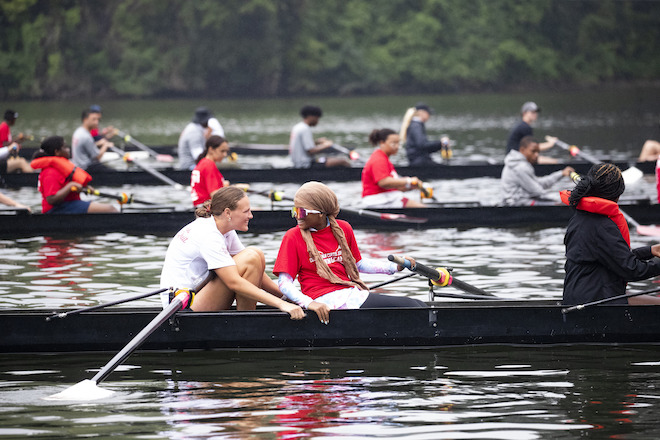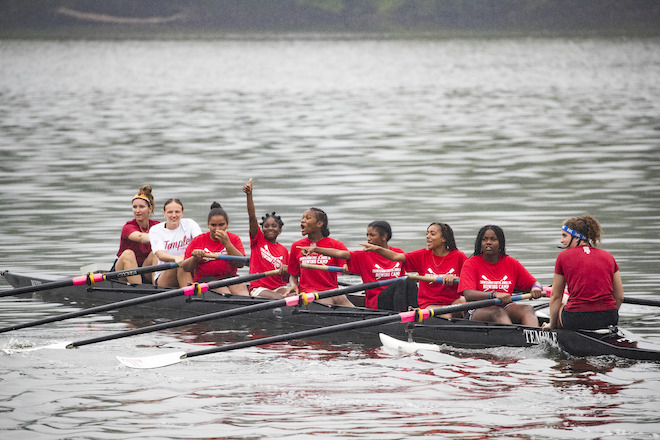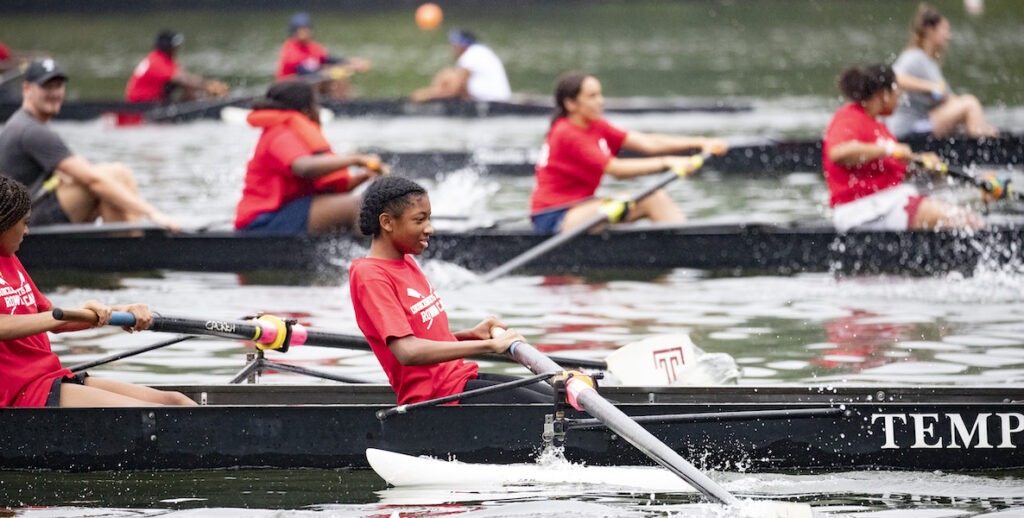All Philadelphians can pronounce Schuylkill. Some can spell it. Few, however, have been on top of the river, doing the thing that Boathouse Row was designed for: rowing crew. This summer, free programs are working to give more Philadelphians — average Philly kids, that is — access to both the rarified river scenery and the sport, while also boosting their confidence. In the process, these programs are helping to turn around crew’s reputation as … intractably Winklevoss-y.
Rowing crew, says head Temple women’s crew coach Rebecca Grzybowski, is “historically, unfortunately inaccessible, a very privileged, elitist sport.” After all, to row, you need both a friendly body of water, a set of specific skills — and a boat that costs about the same as a Hyundai. Only then can you be part of the centuries-old tradition’s cream-colored history, which we’ll get to in a moment.

The people behind the free summer intro-to-rowing camps: for middle schoolers at Temple (July 29 – August 2 and August 5 – 9), and for middle and high school students at Philadelphia City Rowing (three times a summer, including July 29 – August 16) and Parks and Rec (three two-week sessions, including August 5 – 16; $25) believe they can transform the demographic of the sport, and provide opportunities beyond it for more Philadelphians.
Why? For one, unlike golf, baseball, tennis, football, soccer and the vast majority of sporting activities, in crew, as long as you have the physical ability, you can excel in a relatively short amount of time. Why else? Collegiate rowers are in demand. Last: Do something new, and you’ll be proud of yourself and go on to do more new, great things.
But first, students have to get onto the water.

A very brief history of rowing crew
Look at a Thomas Eakins painting, The Social Network, that giant monument to John B. Kelly along Kelly Drive, The Boys in the Boat, or this year’s entire roster of U.S. Olympic rowers, and you’ll see that rowing crew is a very White thing to do. (Seriously, there have been five Black Olympians rowers for team U.S.A., ever.) In 1983, the clothing brand Popular Merchandise changed its name to J.Crew, signaling country club exclusivity, preppy privilege … the Whitest of socio-economic realms.
In 1430 BC Egypt, Amenhotep’s time, people rowed and possibly even competed in rowing. Regattas — the rowing term for race — were a thing in 13th-century Venice. But modern crew derives from 18th-century-ish London, where rowing contests began among royally sanctioned water taxis before showing up as athletic competitions at raah-ther blue-blooded Eton College, Westminster School and Oxford.
From the Thames, it’s pretty much a straight line to the Schuylkill, home of the Schuylkill Navy, founded in 1858, the country’s oldest amateur athletic governing body in the United States, and where, on special occasions, you’ll still run into one or more white-haired men, wearing, if not seersucker, then at least colorful blazers and straw hats called skimmers. So Winklevoss.
Philadelphia City Rowing
George Rowley is in his fifth year as director of programs and community inclusion at Philadelphia City Rowing (PCR), the city’s only nonprofit devoted to offering students year-round access to crew, developing Philly students’ bodies and minds. Rowley, who is African American, was new to the sport when, as a freshman in college, he took a job as a counselor at Parks and Rec’s rowing camp.
“I knew nothing about rowing. I showed up on my first day in a dress shirt,” he says. “Essentially, rowing is reserved for people with affluent backgrounds, with means and resources.” Zero Philadelphia public schools have a crew team, he says. Boys’ Latin is the sole free school — a charter — to offer crew as a team sport. Only Philadelphia parochial and private schools have actual competitive crew teams. So, if you’re a Philly public school student, PCR is pretty much your only option to row competitively.
Rowley’s first summer camp on the Schuylkill showed him the impact learning to row had on Philly students, especially Black and Brown kids from lower-income neighborhoods. They gained confidence. Found their voices. Learned to communicate and collaborate. “Teamwork, hard work, commitment are ingrained in the sport,” he says. “We see kids that are reticent, shy, timid grow as leaders.” High school rowers who’ve been through PCR’s middle school program often become junior coaches, learning leadership skills and providing an example to younger kids — representing.
There’s no doubt: Having crew on your resume can help a high schooler get into college and get scholarships. What’s more, if a college student is athletic but has never rowed, they still have a decent chance of making it onto an NCAA team, even a good one.
Each school year, about 180 middle and high school students take part in PCR’s program, which includes training both on the Schuylkill (they use a boat yard next to Boathouse Row and a dock at Lloyd Hall) and at an indoor facility at 40th and Cambridge streets, near the zoo. Currently, the competitive high school program contains students from Masterman, Palumbo, String Theory, Saul and Central. Like other youth sports programs, PCR also offers college counseling, SAT prep, college application assistance, along with health and nutrition counseling and opportunities to do environmental watershed work.
Each summer, each of PCR’s three, three-week-long “Learn to Row” morning camps for middle and high school students accommodate 60 brand-new-to-crew students. Although the camps typically receive more applicants than they have space for, they also get a lot of no-shows, and call up nearly half their campers from waitlists.
Beginners at PCR don’t have to know how to swim, at least, not at first, but those who continue year-round take free swim lessons with other PCR student athletes. All high school-age rowers must pass a swim test to be eligible to compete.
Rowley is hoping to expand this group’s reach by making regular visits to Strawberry Mansion H.S., Russell Byers (a middle school charter) and South Philly High to recruit more student athletes. Not being able to swim has been a barrier to entry. Another one is transportation to Lloyd Hall. (PCR’s camp offers participants free SEPTA passes for the duration.)
Off the top of his head, Rowley can name a couple PCR kids who’ve gone on to row at Drexel and Jacksonville universities, which is awesome. But he’s most proud of something else: “Our demographics mirror the city’s demographics,” he says, “We have created a diverse, inclusive environment.”
Rowing in college
There’s no doubt: Having crew on your resume can help a high schooler get into college and get scholarships. What’s more, if a college student is athletic but has never rowed, they still have a decent chance of making it onto an NCAA team, even a good one. Grzybowski was a walk-on at Holy Cross University — and ended up medaling in the 2008 World Championships in singles.
“Rowing is probably the only Division 1 sport that you could start learning in college and take it all the way to the Olympics,” she says, “I guarantee there are women who didn’t start rowing until they got to college that will be racing for the United States over in Paris this summer.”
Gryzbowski and Temple men’s crew coach Brendan Cunningham (a Monsignor Bonner grad), would love for their campers to become world-class rowers. But they don’t expect it. They do, however, want to open them up to college in general, and Temple in particular.
The first day of Temple Middle School Rowing Camp is always the same. “We’re on campus, showing [campers] around, exposing them to the university as well and finding the opportunity to say, Temple’s right here, and it’s an incredible place to potentially go to school, especially if you’re local,” says Grysbowski.
The university’s rowing camp is part of an agreement the school made with the City in exchange for help facilitating a $5 million restoration of the university’s circa 1914 East Park Canoe Boathouse (not a part of the original Boathouse Row) in 2015. Since 2017, Temple has worked with 4th District City Councilmember Curtis Jones Jr. and Temple University Campus Police to bring kids from the neighborhood to campus, and from campus to the Schuylkill. Kids from other neighborhoods are welcome, too. (One camp perk: They bus kids from Temple to Kelly Drive.)
Gryzbowski says the students start out nervous, worried the boats will tip. By day two, they’ve grown confident. On the last day of camp, campers race — regatta? — against Councilmember Jones and his City Council team. It’s one of the coach’s favorite moments.
The rowers make posters for their teams. They walk out to music they’ve chosen. Everyone is excited, including the counselors. Then, the middle schoolers “race really hard and cheer each other on,” Grysbowski says. “It’s really fun to see them just get into a sport that four days earlier they had never touched, never been in a boat.”
But it’s also not just about the moment. It’s about the memory. “At the end of the day, they might never touch rowing again,” she says “But they can look back and be like, Well, I’ve done that before.”

